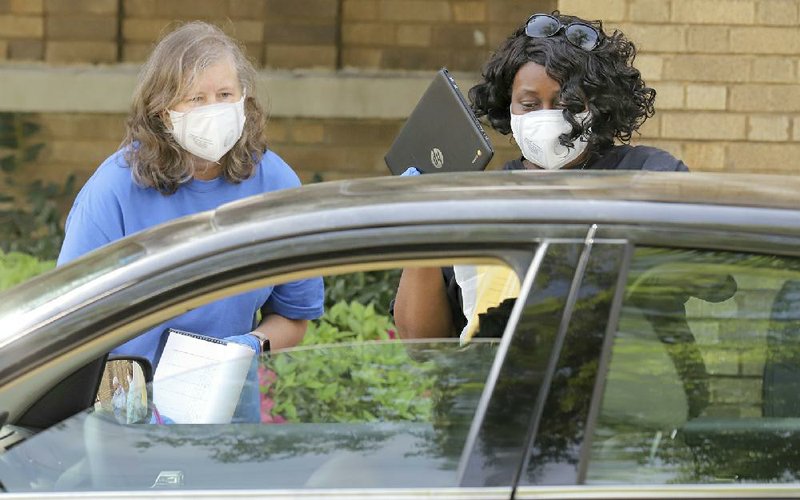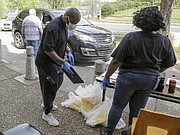There will be no getting back to normal in this unprecedented 2019-20 Arkansas school year.
Gov. Asa Hutchinson on Monday directed that the state's public school buildings remain closed for the rest of this school year -- until near the end of May -- to more than 479,000 students in pre-kindergarten through 12th grade.
Until the school year's end, however, students and teachers are to continue to do schoolwork at their homes using a mix of online, televised and paper lessons from a variety of sources to reinforce core academic lessons taught before school buildings were closed last month.
[CORONAVIRUS: Click here for our complete coverage » arkansasonline.com/coronavirus]
Hutchinson, accompanied by state Education Secretary Johnny Key, made the announcement at the governor's daily news conference in which he provides updates on statewide efforts to slow the spread of the coronavirus, which causes the covid-19 illness.
"While we are having some success in slowing the spread, it is clear that this is still going to go on for some time," Hutchinson said. "As a result of it, we are going to have to continue with our mitigation efforts in this state," including the ongoing closure of school buildings to on-site instruction through the end of the school year.
Hutchinson closed all public school buildings in Pulaski, Grant, Jefferson and Saline counties effective March 13 and all school buildings statewide effective March 17. The original plan called for schools to reopen March 30 after spring break, but that was extended to April 20.
"I know this is a hardship, but I think teachers, parents, everyone is prepared for this," Hutchinson said Monday. He praised teachers and students "for hanging in there and not giving up on this school year and recognizing that education has to continue even during this time of a virus."
Arkansas school systems started the school closure period by providing teacher-developed alternative methods of instruction -- or AMI -- lessons to their students. More recently, the state has offered as an option, or as a supplement, some lessons for kindergarten through eighth grade on public television -- Arkansas PBS. For older students, lesson options are available through Virtual Arkansas and the nonprofit Arkansas Public School Resource Center.
Key said Monday that the Arkansas PBS lessons -- developed in conjunction with the Arkansas Division of Elementary and Secondary Education -- will be extended by two weeks, to May 1.
That gives school districts a few weeks to develop lesson plans for their elementary and middle school pupils, he said. Virtual Arkansas and the Arkansas Public School Resource Center courses can continue through the remainder of the year.
Most of the school districts have indicated that they can continue with instruction through the end of the year. The state's 15 education service cooperatives and the state education agency are available to help school systems that will otherwise struggle to finish the instructional school year, he said.
The efforts to finish the school year may very well include additional acquisition and purchase of technology such as laptops and tablets to ease the exchange of instructional materials between students and teachers.
Key urged educators and parents to be flexible about the at-home learning conditions.
"Our schools and educators should set reasonable expectations for [student] time on tasks when they are developing AMI plans. It is impractical to try to replicate the school experience when children are at home," he said. "We need to help students and parents establish flexible schedules for learning that consider that they may need access to learning supports outside the typical 8 a.m. to 3 p.m. school day schedule."
The focus of instruction in the coming days and weeks should be on the core content areas of math, literacy, science and social studies, Key said. Subjects such as art, music and physical education should be blended into the core subject areas "to create fun learning activities for our students," he said.
Some of the electives, such as foreign language and other high school courses, could have weighted credit associated with them. Educators are encouraged to find flexible ways that students can demonstrate mastery of course concepts, state education leaders said Monday.
"We do urge caution with respect to introducing new content," Key continued, "as it is likely to have limited effectiveness in our current circumstances. Instead, we suggest focusing on the essential standards that have been taught up to the point of the school closure. Reviewing existing student data to determine where students need support and emphasizing mastery of that content should also be the focus."
Special education teachers, gifted-and-talented teachers, English-as-a-second-language teachers, and content specialists in schools and districts should collaborate with general education teachers to help students who have been identified as needing those services, he said.
Teachers will particularly need to align lessons to the requirements of the individualized education plans for students who are in special education programs, but services such as occupational and physical therapy may have to be delayed until school buildings can reopen, he said.
Key asked that districts and schools set times during which teachers can be accessible in a number of ways to answer questions from parents and students.
"Be flexible," he again encouraged, noting that the stresses on families created by the covid-19 pandemic will have an effect on students. "This is a time for more emphasis on support and learning and less emphasis on compliance."
Key also said high school seniors will graduate. Those students who were in good standing as of the end of the third nine-week grading period last month have met state requirements for graduation. But local requirements for those students are still in effect, and seniors are expected to continue their work, in particular in Advanced Placement and career technical courses.
As for graduation ceremonies, he said, some districts are making plans for virtual and traditional ceremonies, but the traditional ceremonies will hinge on Arkansas Department of Health guidance that currently prohibits gatherings of 10 or more people.
Key also said Monday that there will be a ripple effect in the coming 2020-21 school year as a result of this year, and that planning for any adjustments will be necessary in the coming weeks.
Arkansas educators and parents were not at all surprised by Monday's announcement about closing the school buildings for the remainder of the school year.
The announcement came at a time when the number of diagnosed covid-19 cases is increasing and some other states have already closed their schools for the rest of the school year.
DISTRICTS IN STATE
Jim Rollins, superintendent of the state's largest school system, the Springdale School District, said he's proud of Hutchinson for the way he's responded to the covid-19 outbreak.
Rollins also said that the alternative methods of instruction "seem to be working for the vast majority of our students." He attributed that to teachers who are working hard to make sure students are staying connected to the learning that is prescribed for them.
He added that he is optimistic that students will "continue on a positive learning curve."
Michael Hester, superintendent of the 3,400-student Batesville School District, said his district has worked for three years to develop the infrastructure, provide a laptop or tablet for every student, and train teachers to teach a blend of classroom and online learning. Not all families have easy access to the internet, but accommodations are available to them for their students.
"We feel like all we have been working toward is coming to fruition," Hester said. "It doesn't mean we are perfect or as good as we want it to be, but we feel like we have the foundation to really handle this."
The Batesville education program, with a focus on the state's education standards, will go into the summer.
"We plan not only going through the rest of the school year but having a summer reading and math program to pick up our kids ... especially K-5 so we drop nothing on reading."
Another summer initiative is intended to help high school students and their parents connect with colleges.
ADJUSTMENTS MADE
Mandy Neighbors of Bella Vista has a daughter, Kate, in fifth grade at Barker Middle School in Bentonville. Neighbors, a stay-at-home mother, seemed undaunted by the prospect of finishing the school year at home.
"I think we just need to do what we need to do to protect our community," Neighbors said. "It's hard for all of us, but I feel like my daughter is still excelling in school. We're just learning a different way."
One positive to come out of this situation is that kids may become more tech-savvy and, perhaps, develop a greater sense of responsibility for their learning, she said. Neighbors said she is there for her daughter if she needs assistance, but Kate seems to be gaining confidence in doing things on her own.
Susan Hill, a kindergarten teacher at Jones Elementary School in Rogers, said she understands the need to continue with remote education, but she called Monday's announcement "heartbreaking" nevertheless. She said her 5- and 6-year-old pupils are having a hard time grasping why they can't go to school.
"They want to be at school. They crave being there," Hill said. "And it's been hard on me because I'm not able to physically be with them. That's been a challenge."
Thirteen of her 18 students are learning English as a second language. She said she is available throughout the day and into the evening if her kids need her, and she makes sure all of the lessons her children do are in both English and Spanish. She communicates in Spanish with the parents if they have problems.
Creating online lessons that all of her kids understand has been a challenge.
"It's been a bumpy road. But we're getting better at it," Hill said.
A Section on 04/07/2020

